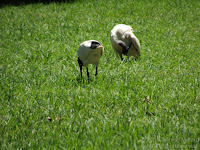AUSTRALIAN WHITE IBIS
AUSTRALIAN WHITE IBIS (Threskiomis moluccus) (See images below)
There was a group of Australian white ibises on a lawn not far from the water at the Royal Botanic Gardens, where some were wearing large yellow tags on each wing. One of the tagged birds was ‘U24’.
These birds have a long curved black beak and a bald black head, although the baldness is not too obvious due to the head color. The Australian white ibis has a very distinct load ‘croak’, which could be heard a number of times. The bird is also supposed to be smelly but this could not be verified during the visit.
The Australian white ibis is about 2 feet long and quite similar to the African sacred ibis. The sexes are similar. It is a wading bird, and (normally) feeds in marshy wetlands off aquatic invertebrates (mussels, crayfish) by digging with its long curved bill. It used to be widespread in Australia.
However, with drying up of marshland for agriculture, the Australian white ibis population has decreased in its natural habitat. But thanks to a remarkable adaptation, this bird now is found in parks and cities, and feeds off scraps and garbage. This new source of food is easily accessible for a bird with such a long bill. Because of this, the Australian white ibis turned scavenger is considered by some as a nuisance.
There was a group of Australian white ibises on a lawn not far from the water at the Royal Botanic Gardens, where some were wearing large yellow tags on each wing. One of the tagged birds was ‘U24’.
These birds have a long curved black beak and a bald black head, although the baldness is not too obvious due to the head color. The Australian white ibis has a very distinct load ‘croak’, which could be heard a number of times. The bird is also supposed to be smelly but this could not be verified during the visit.
The Australian white ibis is about 2 feet long and quite similar to the African sacred ibis. The sexes are similar. It is a wading bird, and (normally) feeds in marshy wetlands off aquatic invertebrates (mussels, crayfish) by digging with its long curved bill. It used to be widespread in Australia.
However, with drying up of marshland for agriculture, the Australian white ibis population has decreased in its natural habitat. But thanks to a remarkable adaptation, this bird now is found in parks and cities, and feeds off scraps and garbage. This new source of food is easily accessible for a bird with such a long bill. Because of this, the Australian white ibis turned scavenger is considered by some as a nuisance.
 |
| Tagged Australian white ibis, Australia |
 |
| Australian white ibis, Australia |
 |
| Australian white ibises, Australia |
 |
| These birds look intimidating |
 |
| Australian white ibises foraging on grass |